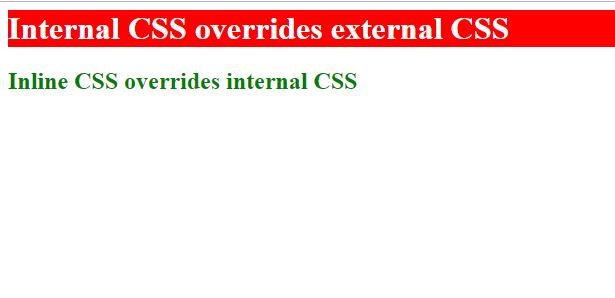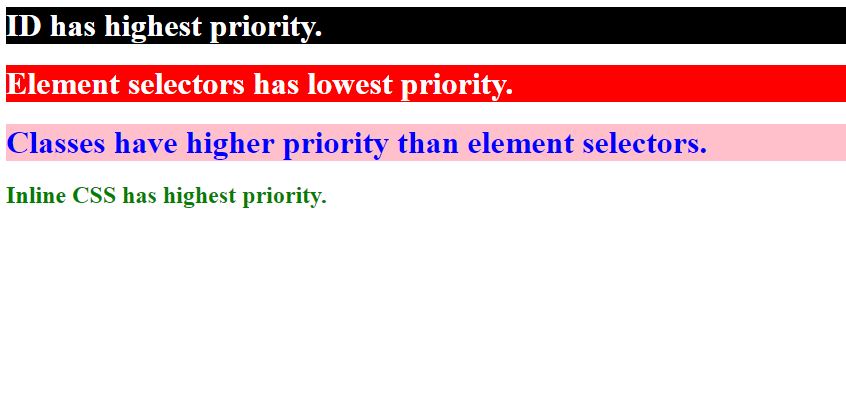当一组以上CSS规则应用于同一元素时, 浏览器将不得不决定将哪个特定的CSS规则应用于该元素。浏览器遵循的规则统称为特异性
特异性规则包括:
通过引用外部样式表应用的CSS样式的优先级最低, 并且被内部和内联CSS覆盖。
内部CSS被内联CSS覆盖。
内联CSS具有最高优先级, 并且会覆盖所有其他选择器。
例子:
< html >
< head >
< link rel = "stylesheet" type = "text/css" href = "external.css" >
< style type = "text/css" >
h1 {
background-color: red;
color: white;
}
h2 {
color: blue;
}
</ style >
</ head >
< body >
< h1 >
Internal CSS overrides external CSS
</ h1 >
< h2 style = "color: green;" >
Inline CSS overrides internal CSS
</ h2 >
</ body >
</ html >" extenal.css"示例1的示例:
h1{
background-color: lightgreen;
}
h2{
color: pink;
}输出如下:

内联内部和外部CSS
特异性层次结构:每个元素选择器在层次结构中都有一个位置。
- 内联样式:内联样式具有最高优先级。
- 标识符(ID):ID具有第二高的优先级。
- 类, 伪类和属性:接下来是类, 伪类和属性。
- 元素和伪元素:元素和伪元素具有最低优先级。
示例2:
< html >
< head >
< style type = "text/css" >
h1 {
background-color: red;
color: white;
}
#second {
background-color: black;
color: white;
}
.third {
background-color: pink;
color: blue;
}
#second1 {
color: blue;
}
.third1 {
color: red;
}
</ style >
</ head >
< body >
< h1 id = "second" class = "third" >
ID has highest priority.
</ h1 >
< h1 >
Element selectors has lowest priority.
</ h1 >
< h1 class = "third" >
Classes have higher priority than element selectors.
</ h1 >
< h2 style = "color: green;" id = "second1" class = "third1" >
Inline CSS has highest priority. </ h2 >
</ body >
</ html >输出如下:

特异性层次
注意:
- 当两个或多个选择器具有相同的特异性时, 最后一个(最新)计数。
- 通用选择器(例如body和继承的选择器)具有最低的特异性。

